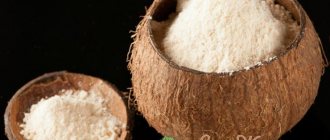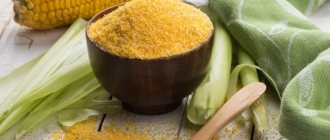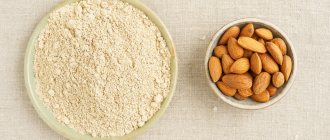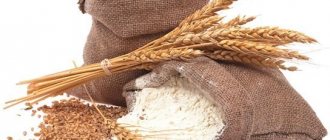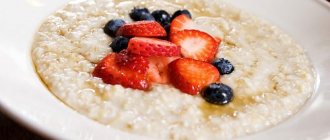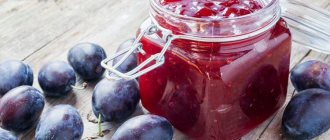In the diet of most people, bread occupies the first position, so its quality should be given special attention. Nutritionists unanimously claim that the properties of bread made from whole grain flour are definitely beneficial for the body and can be eaten even by people on a diet. It contains a large amount of amino acids, fiber, vitamins and minerals. Let's take a closer look at the benefits and harms of whole grain flour, how to bake bread at home, and to whom such baking is contraindicated.
How to obtain whole grain flour
Whole grain, or whole-milled, flour is made from unrefined grains, which are ground together with the flower shell and grain germ, after which they are not sifted. That is, all the components of the grain are used for food and, despite some roughness of the resulting product, it is called wallpaper flour, or one-time grinding, and is considered an incredibly healthy product.
The benefits of the product directly depend on the grain grinding technology itself.
There are two grinding methods:
- Using iron roller machines. Flour coming out of the roller mill retains only 40% of its nutrients. This method destroys the shell and germ at the molecular level, therefore not only the beneficial properties of whole grain flour are reduced, but also its quality.
- Using stone millstones. Flour from stone millstones retains its properties most fully, since this method does not destroy the structure of wheat. This method of obtaining the product retains five times more fiber, two times more minerals, and 1.5 times more vitamins, compared to the first method.
Interesting! According to the traditions of England and Ireland, it is believed that grinding wheat grains on stone millstones transfers special energy to flour, which can protect homes from evil spirits.
Wheat flour benefits and harms
Due to differences in production conditions and plant species, wheat flour is divided into different varieties intended for specific purposes. However, this classification differs in different parts. In the USA, for example, flour is classified into types conventionally based on the type of wheat and the volume fraction of gluten. In Russia and neighboring countries, clear standardization has been adopted, developed in Soviet times and subsequently refined.
Today, the quality of wheat flour in the Russian Federation is established by two GOSTs: “Wheat flour. General tech. conditions" and "Durum wheat flour for pasta".
In the first case, there is a division into 6 grades for baking (wallpaper, extra, highest, 1st, 2nd, grit) and 8 grades for general purpose. Marking, for example M 45-23 or M 100-25, depends on the ash content and grinding level. GOST establishes three grades for pasta flour: highest, first and second.
Due to the fact that the particles of flour from durum grains are larger than baking ones, varieties can be named according to the size of the fragment: “grain” (highest) and “semi-grain” (first).
Types of whole grain wheat flour
Whole-ground wheat flour is divided into two types, depending on the percentage of fruit shell and grain germ content:
- wallpaper – contains up to 96% of the original raw materials. When making it, the shell and embryo are partially sifted out, this is necessary to equalize the size fractions;
- whole grain – contains 100% of the original raw materials. Since it is not sieved, it has particles that are not uniform in size.
Wallpaper flour has the best baking properties precisely due to the homogeneity of the fractions, which is why it is in great demand. The benefits of whole wheat flour are higher, but its baking properties are slightly different, and this should be taken into account when baking bread.
The benefits and harms of whole grain wheat flour
In the production of such flour, grains are ground together with the germ, shell and endosperm. The product is not sifted, as a result of which all useful elements remain in it.
Regular consumption of whole grain wheat flour has the following positive health effects:
- speeds up metabolism;
- reduces blood pressure;
- promotes the proper functioning of the digestive system;
- increases the body's resistance to viral diseases;
- strengthens the heart and blood vessels;
- cleanses the body of various harmful substances;
- prevents obesity;
- lowers blood sugar levels;
- prevents the occurrence and development of malignant neoplasms;
- strengthens bones;
- prevents the development of Alzheimer's disease;
- helps with asthma;
- reduces the likelihood of gallstones forming.
Read: The benefits and harms of coconut milk for women
Please note that this product is not useful for everyone. It can harm the body if you have the following health problems:
- peptic ulcer;
- gastritis;
- gluten intolerance;
- diseases of the pancreas and liver in the acute stage;
- intestinal adhesions.
Chemical composition and calorie content of whole grain flour
Compared to high-quality flour, whole grain flour has a richer chemical composition, which is why its benefits are rated higher. The composition includes microelements such as potassium, magnesium, calcium, phosphorus, sodium, iodine, copper, zinc, iron, as well as vitamins P, PP, E, H, A, B vitamins and beta-carotene.
Wallpaper flour has a fairly high nutritional value: 100 g of product contains 312 kcal. In percentage terms it looks like this:
- proteins – 14%;
- fats – 6%;
- carbohydrates – 78%.
We recommend reading: What foods are good for the brain: to improve performance, top 10 best
In addition, it contains a large amount of plant fibers and pectin substances that improve metabolism. Therefore, despite its calorie content, such flour does not cause harm to health.
Useful properties of rye flour and its types
Rye flour is divided into the following varieties:
- Peklevannaya is a very finely ground product, its yield is 60%. It is used for baking pies and gingerbreads. There are practically no useful substances left in such flour.
- Seeded - finely ground, yield - 63%. During the production of this product, the shell is removed from the grain, so the main part of the beneficial substances is destroyed. But baked goods made from this base rise well, and the baked goods turn out attractive.
- Wallpaper (whole grain) is the best rye flour, it contains absolutely all the useful components and a large amount of bran. It is produced from whole grain, the yield is 96%.
- Peeled - something between the second and third product. This flour is heterogeneous; compared to wallpaper, it contains a smaller number of grain shells.
A large amount of iron in rye flour helps prevent the development of anemia, is involved in hematopoiesis, and is part of hemoglobin, which carries oxygen to tissues.
It contains lysine, which helps in the construction of body cells. It is credited with anti-edematous, anti-inflammatory and immunostimulating effects. The component also strengthens the walls of blood vessels and has a beneficial effect on mental development.
Plant dietary fibers in the shell of rye grains enhance intestinal motility; they are not digested, but absorb toxic substances and remove them from the body, due to which carbohydrate and fat metabolism is normalized.
Consumption of products made from wallpaper flour prevents the development of gallstone disease, mastopathy and breast cancer. Such baking reduces the level of bad cholesterol and stimulates cardiac activity. It is included in the diet for diabetics, as it is a slow carbohydrate, which reduces blood sugar.
Calcium and phosphorus are involved in the formation and maintenance of the skeletal system and prevent the development of osteoporosis. Therefore, eating dishes made from rye flour has a positive effect on nails, teeth and skin.
Rye flour products are included in the diet of athletes, which is justified by their high protein and amino acid content. Scientists also recommend that healthy people replace wheat bread with rye bread, since it is a greater source of vitamins, micro- and macroelements needed by the body.
Regular cosmetic procedures using rye flour improve skin metabolism, remove toxins, smooth out fine wrinkles, and get rid of acne and blackheads.
Useful properties of whole grain flour
The beneficial properties of wallpaper flour are due to the method of milling wheat, which preserves the entire complex of biologically active substances. Therefore, regular consumption of whole grain grain products completely replenishes the supply of minerals and vitamins in the body, and also relieves many diseases (obesity, diabetes, intestinal disorders, atherosclerosis, etc.).
What are the benefits of whole grain wheat flour for human health:
- fiber helps eliminate heavy metals, toxic substances and radioactive compounds from the body, improves intestinal motility;
- reduces blood sugar levels, therefore the product is considered useful for people suffering from diabetes;
- the properties of microelements included in the shell and germ of wheat have a positive effect on the functioning of the cardiovascular system;
- improves memory and vision, has a beneficial effect on the functioning of the nervous system;
- is the prevention of cancer.
Scientists have found that the properties of wallpaper flour have a positive effect on the production of endorphins (happiness hormones), so the product will also be useful for people with various nervous disorders.
Whole wheat flour, what is the benefit?
Are you sure that the best flour is premium flour? Do you know the difference between whole grain flour and refined premium flour?
Our wise ancestors treated their diet very carefully. Food has always been perceived as something necessary for the human body to function fully. Old Slavic national cuisine is very healthy. Russian kvass, porridge, black bread, cabbage soup (borscht), pea soup, lentil soup, spelt, jelly. Any dish of Russian cuisine is a healthy dietary product.
Wheat flour of the highest and first grades is a dummy in terms of vitamins and minerals and, moreover, the most over-chemicalized. Stabilizers, preservatives, bleaches, leavening agents, improvers - our manufacturer does not disclose them on the label.
The expiration date is a good guide to the freshness of the flour and the integrity of the manufacturer. Pay attention to the expiration date of flour. Good flour will have a shelf life of 6 months.
7 reasons not to give children bread
Fresh natural flour has a pleasant sweetish taste of ground grain and a neutral aroma. It squeaks when you squeeze it with your fingers, but leaves no marks on them. Low-quality “improved” flour tastes moldy and bitter, causing a slight burning sensation on the tongue.
REPLACE refined flour with whole wheat flour. It contains more useful substances than regular ones.
The content of nutrients in flour depends on the amount of bran particles remaining in it - components of the grain shell. The less bran is separated from the grain, the coarser the grind is considered. It is called low grade flour. The less bran remains in the flour, the whiter it is and is called premium flour. Since bran contains more different vitamins and minerals than the inner part of the grain, the coarser the flour is ground, the higher its content of vitamins, minerals and dietary fiber. Flour made from whole grains is beneficial for the body, since the bran is not removed from it at all.
Whole grain bread contains sufficient amounts of dietary fiber (fiber), B vitamins and vitamin E, minerals, iron, zinc and selenium, antioxidants, and plant estrogens.
Bread made from whole grain flour is rightly called a medicinal product against cancer, obesity, diabetes, atherosclerosis, and decreased intestinal motility. Grain bread effectively removes harmful substances from the body - salts of heavy metals, radioactive substances, toxic components, residues of products of biological origin, and increases life expectancy.
Source: vk.com
If this article on our website was useful to you, then we offer you a book with Recipes for living, healthy nutrition.
Vegan and raw food recipes from famous Italian chef Angela Agrati-Prange
. We also offer you a selection of the best materials on our site according to our readers. You can find a selection of the TOP best articles about a healthy lifestyle and healthy eating where it is most convenient for you: VKontakte or Facebook
If the page is not displaying correctly, the video is not playing, or you find an error in the text, please click here.
News from our partners
Whole grain flour for weight loss
The benefits of whole grain grains are invaluable for overweight people due to their high fiber content. The product has a low glycemic index, and the properties of fiber slow down the absorption of glucose and normalize blood sugar levels.
In addition, fiber saturates well, gives a feeling of fullness for a long time and is practically not absorbed by the body. This has a beneficial effect on intestinal function and normalizes stool, which is important for people on a diet.
For people losing weight, the high concentration of essential vitamins and minerals in whole grain bread will also be useful, which, due to the refusal of certain foods, the body has nowhere else to get: so that the diet is not harmful to health, such a product should be in the diet every day.
The benefits of whole grain flour
The name of the product speaks for itself - it is obtained from whole, unrefined raw materials, while for the production of higher grades only the inner part of the grains is used. Whole grain flour (or single-grind flour) is made not only from wheat, but also from other grains and seeds - buckwheat, rye, oats, soybeans, barley, flax, chickpeas, etc. The raw materials are ground once and not sifted, due to this the mass in structure resembles semolina and has a gray or yellowish tint. As a result of minimal processing, the particles are heterogeneous and of different sizes - from 0.5 to 1.5 mm.
Single-grind flour is superior to higher grades in terms of the content of useful substances, because the latter mostly consist of starch. This means that products made from such raw materials, despite their external unattractiveness, are much healthier for the body than white wheat bread. After all, they preserve all the substances contained in the grain.
Due to its rich chemical composition, single-grind flour can be called a natural dietary supplement. It contains a number of useful microelements (Zn, Mg, Ca, Mn, Na, K), vitamins B, E, PP, pectins, fiber, plant fibers, proteins, beneficial bacteria.
Thanks to this composition, the product has a positive effect on many organs and systems and improves the condition of the body as a whole. Its benefits are as follows:
- Vitamin A acts as a powerful antioxidant, removing waste and toxins, and also has a beneficial effect on the visual organs.
- Vitamin E is also a strong antioxidant. It helps the body get rid of harmful substances, activates the immune system and prevents premature aging.
- B vitamins support the nervous system.
- Vitamin PP (niacin, nicotinic acid) promotes normal hormone production.
- Copper is necessary for the formation of tissues and cells, as well as the secretion of gastric juice and other digestive enzymes.
- Magnesium helps normalize blood pressure and protects blood vessels.
- Iron helps maintain normal hemoglobin levels.
- Phosphorus, potassium and calcium are involved in the formation of bone and muscle tissue.
- Fiber helps cleanse the body of toxic substances and improve intestinal function, stimulating peristalsis.
- Dietary fiber helps normalize blood cholesterol levels.
By replenishing the body with useful substances and promptly removing harmful compounds, whole grain flour helps prevent the development of a number of dangerous disorders - oncology, diabetes, atherosclerosis, obesity, etc. In addition, it has a low glycemic index (wheat - 40-55, rye - 40, buckwheat - 50). This means that it does not cause sudden jumps in blood sugar levels and helps normalize this indicator.
Single-grind flour also contains much fewer calories than white flour. And due to the presence of fiber and coarse dietary fiber, it is broken down and digested slowly, and the feeling of fullness persists for a long time. Therefore, products made from these raw materials are recommended for those who are watching their weight.
How to make whole wheat flour at home
A useful product can be obtained at home without much difficulty: the process does not require any special knowledge or skills.
To do this you need:
- Whole grain wheat. Before grinding, the wheat should be prepared: washed, dried (at least 10 - 12 hours), and selected rotten and spoiled grains.
- A special mill (you can use an electric blender or coffee grinder). Fill the container halfway and grind, then use a small sieve to separate the large fractions and grind them again.
- The finished flour must be dried. To do this, spread it in a layer of 1.5 - 2 cm on paper and leave it for 24 hours in a dry place, stirring periodically. As soon as it stops sticking to your hands, pour it into a paper bag (fabric bag) or use it for its intended purpose.
If you don’t have special kitchen equipment at hand, you can get this useful product in an ordinary mortar. However, this very labor-intensive process will take a lot of time.
The benefits and harms of whole grain wheat flour largely depend on the method of its production. Thus, the benefits of a product obtained, for example, in a mortar, will be an order of magnitude higher than in a coffee grinder. This is explained by the fact that in a coffee grinder or blender the raw material is heated during the grinding process, and this has a negative impact on its beneficial properties.
We recommend reading: What are the benefits of maple syrup, how to make it at home
Features of baking from whole grain flour
The product has some features that should be taken into account when making baked goods:
- The dough does not rise well and may fall due to its high fiber content. The resulting product is coarse, which is why wallpaper flour is not used when making buns. More often it is used to make hearth bread, muffins or flatbreads;
- before kneading the dough, the flour should be dried and sifted to saturate it with oxygen;
- whole grain dough requires more moisture, since large fractions absorb liquid: therefore, according to the recipe, a little more liquid is added to such dough;
- The finished dough cannot be sent straight into the oven; it needs to sit so that the moisture is completely absorbed: then the product will turn out more fluffy and airy;
- Do the dough filling at 50% otherwise the baked goods will not rise and will not be baked.
To improve the structure of the dough, it is recommended to add a little premium flour. It will not cause significant harm to people on a diet, and the baking result will be more predictable.
How to make bread with whole wheat flour
Cooking from wallpaper flour is no more difficult than from varietal flour. The benefits of whole grain bread are enormous, and every housewife should master this art.
To prepare the dough you will need:
- flour – 570 g;
- dry yeast – 2 tsp;
- salt – 2 tsp;
- sugar – 1 tsp;
- water – 400 ml.
Cooking method:
- Mix all dry ingredients (flour, sugar, salt) in a bowl.
- Make a funnel in the center and pour in the yeast diluted with warm water, then add water in a thin stream, stirring constantly;
- Knead the dough with your hands until smooth and place in the pan, sprinkling flour on top.
- Cover with a clean towel and place in a warm, dry place to rise for 40 - 45 minutes.
- Place in the oven preheated to 200°C and bake for 40 minutes.
- Remove the cake from the pan, turn it over and bake for another 5 - 7 minutes. to form a golden crust.
The finished bread, covered with a towel, should cool at room temperature, and only then can it be put into the bread bin.
Harm of whole grain flour and contraindications
Despite the benefits of whole grain bread, in cases of contraindications from its use, harm to health is possible:
- people with intestinal adhesions;
- those suffering from gastritis, stomach ulcers;
- for acute inflammatory infections of the gastrointestinal tract.
Large fractions can cause harm to the intestinal mucosa of small children, so it should be added to the diet with caution.
In addition, along with pieces of grain, there is a possibility of harmful bacteria entering the body that were not killed during baking. Therefore, for people with a weakened immune system, such baked goods can also cause harm to the functioning of the digestive system and intestinal microflora.
Harm of whole grain flour
Whole wheat flour has its disadvantages. It can irritate the mucous membrane of the stomach and intestines, as it has fairly large particles. Therefore, people suffering from gastritis and cholecystitis should be careful when eating dishes made from whole grain flour. This type of flour has a special microflora on the grain shells, which can sometimes disrupt the overall composition of the intestinal microflora. Also, sometimes heavy metals accumulate on the shells of grains, which accumulate in wheat growing in environmentally unfavorable areas.
It is worth remembering such disadvantages when choosing flour. To understand how your body perceives this product, just a few samples are enough. If the body has no consequences after this, you can eat the product safely. But the presence of harmful substances can be avoided only by choosing a product produced in environmentally friendly regions. Whole wheat flour is not popular in cooking. It rises poorly and does not blush, which is why products made from it look unpresentable. It’s impossible to make puff pastry with whole wheat flour, and simple pastries are rough.
But from the point of view of nutrition, it is precisely this roughness that the body needs. The fiber contained in whole grain flour provides intestinal massage and provides the body with all the valuable substances contained in the golden grain. The calorie content of whole grain flour is identical to regular flour, and bread made from it is an excellent source of energy and strength. That is why in many folk recipes it is recommended to use whole grain flour. You can buy whole grain flour in any large supermarket or order it online. Baking from such a product will be more useful than ever.
